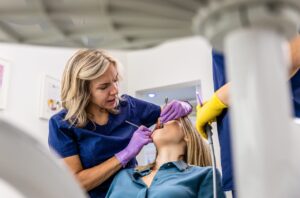How Technology is Transforming Dentistry
The dental industry has undergone a significant transformation due to technological advancements. From improving patient care to streamlining administrative tasks, modern technology plays a crucial role in enhancing efficiency and accuracy in dental practices.
“Technology is not just changing dentistry; it is redefining the patient experience.” – Dr. Michael Peterson
Key Technological Innovations in Dentistry:
- Digital Imaging and 3D Scanning: Improves diagnostic accuracy and treatment planning.
- Artificial Intelligence (AI): Enhances predictive analysis and patient record management.
- Teledentistry: Expands access to dental care and reduces appointment wait times.
- Laser Dentistry: Provides less invasive procedures and faster healing times.
- Electronic Health Records (EHR): Streamlines data management and enhances communication.
- CAD/CAM Technology: Allows same-day restorations, reducing patient visits.
- Automated Appointment Scheduling & Reminders: Improves patient engagement and reduces no-shows.
The Impact of Digital Dentistry
With the rise of digital impressions and 3D printing, dental procedures have become more precise and comfortable for patients. Intraoral scanners replace traditional molds, providing a more accurate representation of a patient’s teeth and reducing discomfort. 3D printing allows for the rapid creation of dental prosthetics, crowns, and aligners, reducing the turnaround time for restorations.
AI-driven diagnostic tools assist dentists in identifying early signs of oral diseases, such as cavities and periodontal issues, leading to more effective preventive care. By integrating AI with digital imaging, dentists can detect anomalies with greater accuracy, minimizing human error.
Benefits of Implementing Technology in Dental Practices
- Enhanced Patient Experience – Modern technology ensures less invasive procedures, shorter treatment times, and improved comfort.
- Increased Efficiency – Automated scheduling, digital records, and AI-powered diagnosis improve workflow and reduce administrative burdens.
- Better Treatment Outcomes – High-precision tools like laser dentistry and CAD/CAM systems ensure accurate restorations and faster healing.
- Greater Accessibility – Teledentistry allows patients in remote areas to access consultations without traveling long distances.
- Cost Savings – Digital workflows reduce material waste, enhance productivity, and lower overhead costs.
The Future of Dental Technology
The integration of robotics, augmented reality (AR), and blockchain technology will further revolutionize the dental industry. Robotics-assisted surgeries promise greater precision in complex dental procedures, while AR enhances patient education by visualizing treatment outcomes before the procedure begins. Blockchain technology can improve the security of patient data and streamline insurance claims processing.
Investing in modern technology is no longer an option but a necessity for dental practices that aim to stay competitive. By adopting the latest innovations, dentists can enhance efficiency, improve patient satisfaction, and ensure long-term business success.






